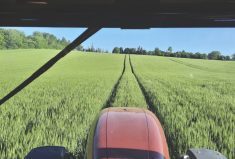Pay attention to what you are seeing and hearing at the elevator and from the neighbours in regards to the grade and quality of grain coming off combines this fall. This will help you understand what’s out there and where your production fits into the big picture. Is your quality and protein above or below the average? Knowing this can provide marketing opportunities for you when grain companies start looking for specific quality and protein for blending purposes. You may be able to extract an extra nickel or dime more per bushel for your grain if you have what buyers need.
Read Also

Ontario farmers partner for success
Ontario business partners, Matt Bergman and DJ Wassenaar, have been farming together for 10 years. Their focus on integrating unconventional…
Don’t be afraid to let as many buyers as possible know what you have — otherwise they won’t know to call you when they need what you have. Keeping your production a secret does not give you a marketing advantage!
As I mentioned in the last issue, being aware of some details around grade and protein spreads can help you extract more value out of your grain.
Grade spreads
Early in the growing season, the grain buying industry can only assume that if we have a normal year we will end up with (based on historical numbers) a normal amount of production, including a normal breakdown of different grain qualities.
Based on that, grain companies set their grade spreads at what we would call “traditional levels” at this time of the year as they wait to see the true harvest results. For example, a normal spread between a No. 1 down to No. 2 CWRS is -$0.15 per bushel, and from a No. 2 down to a No. 3 is -$0.40/bu.
If we have an exceptional harvest and the quality of the grain is above normal, you can expect that the spread between a No. 1 and a No. 2 and a No. 3 will narrow in, as there are ample stocks of high quality grain available to meet demand. Buyers won’t be willing to pay as much of a premium for high quality in an exceptional year.
In a year with more low quality grain, you can expect grade spreads to widen out between the higher and lower grades. The amount that the spreads change will depend on how much of the total crop falls into each grade and what buyers are looking for. Once the grain buyers understand the overall quality of the prairie crop, compared to the rest of the world, they decide what they will pay to buy our grain versus someone else’s. Then they will set grade spreads so they can buy the right amounts of different grades of grain to blend to meet buyers’ specifications, and still make a profit.
Protein spreads
Protein spreads work the same as grade spreads — they are based on market demand for protein and what we can supply. If we have excess protein, the spreads will be narrow — buyers won’t pay a premium for something that is readily available. If protein is low, spreads for higher proteins will increase as buyers try to attract higher protein grain to blend to meet buyers’ specs.
One thing I have found over the past few years is that every grain company seems to use a different pricing scale for protein spreads. For example if you contracted a No. 1 CWRS, 13.5 per cent protein and end up delivering grain with a different protein content, one company may be paying two cents for each tenth per cent protein for levels above your contracted grade and deducting four cents per tenth for levels below your contracted grade. Another company may do two cents per tenth up or down from your contracted grade. It all depends on what they see as market and blending risk. There are no set prices for protein so the spreads will often vary between companies and can change daily or hourly.
So how can you use this knowledge? Contract what you grow.
If on average you end up harvesting No. 2 wheat more years than anything else, you should be contracting and pricing a No. 2 wheat instead of the standard contract grade of No. 1.
Under current contracting you would lock in a grade of No. 1, 13.5 per cent. If you deliver a No. 2, 12 per cent wheat, you’ll be discounted the grade and protein difference based on the spreads in effect the day you deliver.
If the harvest brings large amounts of No. 2 and No. 3 low protein wheat, grade and protein spreads will likely have widened out since spring. Let’s say the grade spread widens out for a No. 1 to a No. 2 to $0.25/bu. and the protein spread widens out to a five cents per tenth deduction for protein below contracted specs. In this scenario you will be getting paid less at delivery than you would have if you had originally contracted your grain as a CWRS No. 2, 12 per cent.
Locking in grade spreads can also be something to consider with canola to protect yourself from widening spreaders, especially when pre-pricing before harvest.
Little things can make a marketing difference and keep money in your pockets.
This article was originally published in the June 7, 2016 issue of Grainews.















